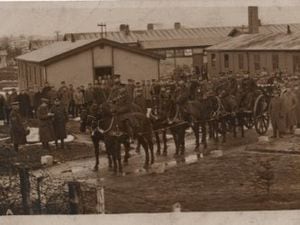The story of the Staffordshire village ravaged by Spanish flu as millions died
The evidence is there, etched on the square headstones that stand in neat rows like worn, white dominoes.

The brief epitaphs on the crowded memorials are among the last reminders of one of the greatest medical catastrophes endured by mankind.
Under leaden skies on a rain-lashed afternoon, gales forcing dead leaves to dance across the clipped grassed surface, I studied the words on Great War tombs. They are not the flowery prose of those who died gallantly defending their country.
They are curt, emotionless anthems to a pandemic that brought the world to its knees.
This is Cannock Chase War Cemetery. And what lies under the wet soil at my feet is akin to a plague pit.

Set up in 1916 to “serve” a nearby 1,000-bed military hospital, this is the last resting place of 100 Commonwealth troopers, the majority New Zealanders who succumbed not to gas, bullets or shells, but to a lethal illness first christened “la grippe”, then re-branded as Spanish flu.
Many of the 286 German prisoners of war interred in this quiet corner of Staffordshire perished from the same pestilence.
This is a monument to the fallen of a flu more lethal than any other.
The shocking statistics reveal the scars left by the savage disease. From 1918 to 1919, when Spanish flu struck in three waves, a minimum of 50 million people died – and the toll may be twice that.
Britain lost 228,000 and, with casualties rising in their communities, schoolgirls skipped to a new song: “I had a little bird, its name was Enza, I opened the window, and in-flu-enza.”
It has inevitably been compared to our recent coronavirus pandemic. Unlike Covid, Spanish flu appears to have targeted the most robust. It struck swiftly. Victims who appeared healthy at breakfast were cold by teatime.
In that terrible 12 months, the flu claimed more lives than were lost to Black Death during the span of its peak destructive years – 1347 to 1351.
By the time the epidemic had finally burned out, only one place on the entire planet – Marajo, an isolated island in Brazil’s Amazon delta – had escaped its grip.
We still know little about the disease. We know those who died were unwitting victims of the First World War: it festered in the trenches and was carried home by soldiers returning from the front.
We know, the flu itself did not kill in vast numbers. Most victims lost their lives to bacterial pneumonia which took hold of their weakened bodies. The medical profession had yet to discover penicillin, a drug which combats such invasions.
We know the wrong country has been blamed for the epidemic. The first documented case took place in Kansas in March, 1918, but Allied censorship quashed press reports on the pandemic. News had to be upbeat, morale could not be damaged.





